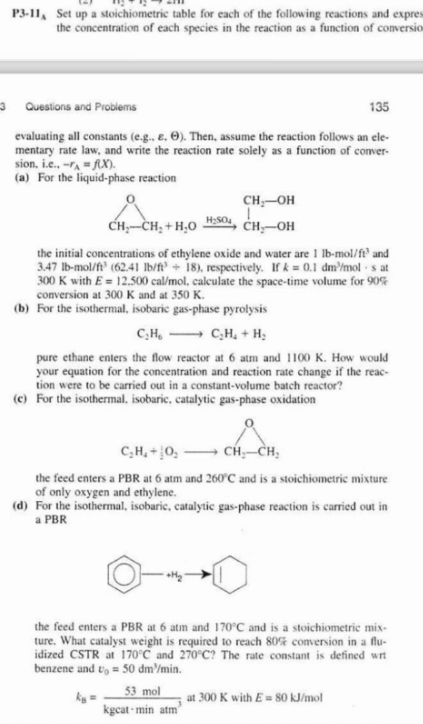Answered step by step
Verified Expert Solution
Question
1 Approved Answer
Can you help me by solving problem P 3 - 1 1 assuming that all reactors are batch reactors and that the input conditions are
Can you help me by solving problem P assuming that all reactors are batch reactors and that the input conditions are the initial ones and with variable volume I only need the stoichiometric tables for each sectionevaluating all constants eg Then, assume the reaction follows an ele
mentary rate law, and write the reaction rate solely as a function of conver
sion, ie
a For the liquidphase reaction
the initial concentrations of ethylene oxide and water are and
respectively. If s at
with calculate the spacetime volume for
conversion at and at
b For the isothermal, isobaric gasphase pyrolysis
pure ethane enters the flow reactor at atm and How would
your equation for the concentration and reaction rate change if the reac
tion were to be carried out in a constantvolume batch reactor?
c For the isothermal, isobaric, catalytic gasphase oxidation
the feed enters a PBR at atm and and is a stoichiometric mixture
of only oxygen and ethylene.
d For the isothermal, isobaric, catalytic gasphase reaction is carried out in
a PBR
the feed enters a PBR at atm and and is a stoichiometric mix
ture. What catalyst weight is required to reach comersion in a flu
idized CSTR at and The rate constant is defined wrt
benzene and
with

Step by Step Solution
There are 3 Steps involved in it
Step: 1

Get Instant Access to Expert-Tailored Solutions
See step-by-step solutions with expert insights and AI powered tools for academic success
Step: 2

Step: 3

Ace Your Homework with AI
Get the answers you need in no time with our AI-driven, step-by-step assistance
Get Started


